Thumping over the dirt road, I raised the cell phone to my ear. Yeah, I know. But it was midnight on a weekday in the backcountry. I wasn’t going to see any other traffic.
The phone rang three times.
“Eh?” Came my brother Jeff’s sleepy voice.
“Hey man, sorry about the late call. I just realized I should probably tell someone where I was going,” I said.
“Oh, great.”
We’d set this system up a year or two before. I told him where I was going climbing, and if I hadn’t checked back in by that night, he was to contact the appropriate authorities. So far, he hadn’t needed to do so.
“So this one’s in Sedona too. It’s called Rockfall Peak.”
“Appropriate.” Jeff grunted.
“This one’s probably going to take a while.”
“Yeah? Let me guess… no trails anywhere, bad rock everywhere, no climbing partner, possibly unclimbed,” my brother said, heavy with sarcasm.
“Damn, you’re good.”
“Uh huh.”
“Thanks, dude. I really appreciate it.”
“Rockfall Peak. Got it.”
Soon after, I found a place to park not far from the entrance to Red Water Canyon – I was planning to follow it in the morning. One problem I’d be dealing with was legal; not only is the only road into this canyon closed and private, but – in an impressive feat of engineering – the entire mouth of the canyon is fenced off. Worrisome, yes, but I’d been in the canyon once before. Delayed by difficult climbing and facing approaching darkness, I was forced to rappel into Red Water from the west face of a frighteningly steep peak called the Fortress. At the time I knew nothing about the canyon except that it was closed. And I had ample time on the hike out to ponder being shot, arrested, devoured, or any one of 2,836 other unpleasant consequences. I prepared a story, should I be accosted on the way out.
As it turned out, I didn’t need it. Red Water Canyon was mostly deserted, and I only saw a few buildings and some sleeping horses. Perhaps all the people were asleep as well.
This time I’d be headed up the canyon in the morning, though, so there might be a few folks around. Thus I resolved to stick close to the east wall of Red Water, following the main drainage, or wash. The full moon shone directly on me as I packed gear for the climb. It was so bright that for a moment I debated starting immediately. But it wouldn’t have been a good idea. Certainly I could hike in these conditions, but once I hit rock it’d be a different story. Best to stay with plan A.
I was in the wash by six the next morning. A bit chilly, but not too bad when you’re moving. I set a good pace despite the weight; the wash was filled with small rocks at this point and stayed relatively flat. A mile went by, then another, and another. Red Water Canyon is deep enough that no light hit it yet – but the high walls of the mountains around me were turning yellow and orange as the sun rose.
![Sedona]()
Up ahead of me, Rockfall Peak’s south face came into view. It rises only some two thousand feet above the wash, but those two thousand feet hold layer upon layer of cliffs. 5.12? 5.13? 5.impossible? It didn’t matter. I’ve seen every face of this mountain, and most of them look like invitations to certain death. But the slash of a deep gully splits the west wall, running all the way up to a notch between Rockfall’s twin summits.
So my plan was to head for this notch. It might provide a way, but nothing was certain. For one thing, I’d never seen into the gully itself. The walls were too steep, the ground within too hidden by shade and brush. It could be filled with loose rock or unclimbable cliffs, and I wouldn’t know. And even if I made the notch, it would be foolish to assume that the cliff bands which guarded both summits simply stopped there. But – as a great climber once said, a real adventure demands an uncertain outcome. It’s nice to know you’re going to make the top. But it takes something away. Far better to achieve what you weren’t sure you could accomplish.
Two more miles down. The wash started splitting as channels came down from different peaks in the area. This meant that the one I was in started getting thinner, more choked with vegetation, steeper, harder to navigate. I was now moving alongside the massive west wall of Rockfall Peak – when I could see it. But I kept watching for a wash on the right which would lead me to the notch.
Another mile. Had I missed it? There was no break in the walls, had been none that I could see. But now I was going up. And the going was harder. Hands which had been in my pockets had to come out and help me claw my way up the wash, which was increasingly steep and filled with loose rock. A few times I had to leave it to avoid obstacles like giant, dead trees and boulders which had become lodged in the narrow walls. Upward.
And even steeper. It wasn’t difficult enough to stop me, but now I was into 3rd and 4th class terrain. And I had to exit the wash more frequently for no less vertical (but less loose) ground on the sides. I hauled myself upward, clinging to manzanita and holly. The loose dirt under my feet provided little in the way of footing. Getting a better grip, I looked down.
What was this?
Something that looked like a piece of tire had caught my eye. A scrap, maybe? No. I knew that shape, the slight curve. I picked it up; this was pottery – Sinagua pottery, probably. The Sinagua were an indigenous people that lived in the Sedona area from around 600 – 1400 A.D.; the name is Spanish for “without water,” due to their ability to live in such an arid land. The Sinagua left ruins, petroglyphs and cliff dwellings throughout the area, many of which I’d discovered during climbs and hikes here. I’d also found arrowheads and corn as well as the occasional pottery. The question was, what was pottery doing here? There were no ruins nearby, and certainly none above me. That I knew of, I reminded myself. Where had it come from?
![Sedona]()
But I didn’t really have the time to look. Truth was, I’d been putting this climb off for almost a year. You can’t really hike comfortably in Sedona during the summer, and this spring, well… I don’t know. I had a bad feeling about this mountain. When you’ve climbed a while, you get to trust those feelings. Somehow, every time I had a free day to climb, I’d made some excuse not to come here.
Nine-fifteen. Further up I went. The brush was so thick that I couldn’t see anything ahead of me – much less always look for a break in the wall. But although I felt I’d gone much too far, I’d seen no options on that side; just the same half-hidden cliffs. A huge manzanita blocked my path, and I squeezed around it, snapping off branches against my arm as I did so. The sound reminded me of a xylophone; plink-plink-plink-plink went the pieces as they broke on my biceps. I opened my eyes as I passed the manzanita – it’s never too wise to keep them vulnerable at such times – and suddenly the view opened up.
Damn it!
I wasn’t anywhere near the notch. In fact, I was looking down into Tonnoby Canyon. I’d gone around the whole west face of Rockfall and was at a pass on the north side of the peak. Dark walls loomed to the south. But in every other direction, there was nowhere to go but down.
Big drink of water. I was going lighter than usual, knowing that my time was limited and that weight would slow me down. The cliffs loomed. I could only see one section, a couple hundred feet of crumbling rock – the kind Sedona is infamous for. But I was still a thousand feet from the top. Worse yet, I’d seen this side of the mountain before. Last year I’d kicked my way over an overgrown summit plateau north of here, hoping to get a first good look at the north face of Rockfall Peak. I ran out of water, slashed my left knee up considerably, and almost stomped on a western diamondback during a sunset return. But I’d seen, and photographed, this side of Rockfall. I remembered not one, not two, but three bands of cliffs stacked on top of each other, guarding the summit.
And I remembered thinking you’ll have to find another way. Because there is no way in hell you’ll be able to climb that north face.
An apple followed the water. What were my other options? I’d looked hard for the notch on the hike in and seen nothing. Turn back and I would be descending a thousand feet through that nasty wash to level ground (11:00) and then, assuming I could find the right gully, (11:45) heading up that to the notch (3:00), thence to the summit (4:30), back to the notch (5:30) and… well, sunset was around six. And those estimates assumed that nothing went wrong. My experience climbing in Sedona was that something usually did.
So why not try the face? Yeah, it looked bad. All right, so I’d once decided it wouldn’t go. But to head back wouldn’t be to try another route. To head back meant it was over.
Over? That’s ridiculous. It’s not over.
Okay, “over” just means you’ll hike back to the car, get lunch in Sedona -
Mmmm. Lunch in Sedona.
Shut up!
- and come back some other day. Sure. That’s what you’ll do.
Ten o’clock. I dug the toes of my left foot into a little dirt hummock – just enough to hold me where I was, no more weight. It couldn’t take much. Right hand, up to a side-pull, only good if I kept my body hanging left. Now, left hand up to a handful of finger-thick plants growing horizontally out of the rock. My only solid hold, there. Shift weight. And pull. Up. The ten inches I gained enabled me to stretch my right hand just far enough up to grip a stout manzanita branch. Up again.
![Sedona]()
The rope slithered up the wall behind me as I moved. Fifty feet below me, it was coiled next to my pack, with the very end attached. I climb like this sometimes; the pack is heavy and unwieldy enough that it could make the difference between my ability – or willingness – to solo harder stuff. It certainly isn’t going to stop me if I fall. In all likelihood, I’d fall past it, crash somewhere, and then the pack would fall down on top of me. Adding the proverbial insult to injury. Or death. But without the weight I’m stronger. And trailing the rope gives an odd, illogical feeling of confidence, as though I really am climbing with a partner, who’s down there belaying me.
A small, quiet partner who isn’t ready to lead yet, maybe.
The rock above me steepened perceptibly, and I leaned back from my perch to study it. Oh, I could climb it. And with the rope, I wouldn’t have to worry about downclimbing it, either. But could I solo it? That’s always the question. I imagine that for a pure rockclimber who only ever climbs roped, it’d be difficult to come out here and decide what you’re willing to solo or not. I’ve being doing this long enough to have a fairly good grasp of my abilities and limits. In fact, I’ve been at it so long that I must be either pretty good or pretty lucky to still be doing it.
Or maybe a little of both.
Would that luck run out today? There are things you can’t control… rockfall, thunderstorms, avalanches. Things that have killed some of the best climbers who ever lived. It’s hard not to think of them when the abyss beckons from just over your shoulder.
Up again. There’s a strategy to climbing in Sedona – with the difficulty of the climbing and the legendary worthlessness of the rock, taking a direct line is rarely the best or easiest way. Better by far to climb some and traverse left or right before scaling the next wall. Which was what I did. I zig-zagged through the face, and at last pulled myself onto unsteady ground above the first band of cliffs.
Two to go.
And the next one looked rough. After a small, brushy slope, a few hundred feet of rotting sandstone soared before me.
Well, first things first. I found a relatively flat spot and started hauling my backpack up. Due to loose rubble at the edge of the cliff, I stayed back a bit and couldn’t see it rise for the first hundred feet.
Which was when it caught.
I moved to the right and pulled. Moved to the left and did the same. I put all hundred and eighty pounds into it. I lowered and raised it.
Nothing. It wouldn’t come up.
Eleven a.m. Swearing, I found a solid juniper as an anchor and rapped off the cliff. All the weaving I’d done on the way up had worked against me, and the pack was jammed in some underbrush growing on a tiny ledge. I lowered to it, somehow worked it loose and got it on my back with one hand. Lugging the pack, I struggled back, able to Batman up the rope to the top again.
The second band of cliffs surprised me by going easier than the first. Though they were steep, the rock was slightly better, which meant I was willing to make harder moves. I also stopped twice on the wall to haul my pack up, hoping to prevent a repeat of what’d happened earlier. Though airy, the wall wasn’t too technical. Still, I did knock the crap out of my right ankle when a handhold tore out and landed on it. But I was able to shrug the pain off. I began to feel like I might make the summit after all. Higher now, other mountains appeared – the San Francisco Peaks, north of Flagstaff. Bill Williams Mountain and Sitgreaves, to the northwest.
![Bill Williams Mountain]()
And once or twice I even forgot there was a third cliff band, still looming ahead of me.
The sun lay directly south as I topped out and stared up at the last wall. It wasn’t as high as the last, nor as steep as the first. But a grim overhang lay directly in the center of these cliffs, coming in from steeper ground to the east. Rock layers are like this in Sedona – you find a band of limestone or a holdless stripe of soft rock and it runs around a whole mountain. And it stays at the same elevation the entire time. I’ve had climbs halted due to a mere fifteen feet of unclimbable rock. And this overhang stretched as far as I could see to the west as well.
I couldn’t discern a way past it. Slowly, my ankle started to ache. I looked down; blood had run over my climbing shoe, turning the orange into maroon. Maybe, when I’d looked at the north face and decided I couldn’t climb it, I’d been thinking of this last cliff. Maybe I wouldn’t make it after all. As below the north face, I froze, unsure of where to go. I couldn’t even see a place to start.
You can always go down. That’s why you brought the rope, right?
That helped. No matter how bad it got, I had a rope and a generous chunk of slings. If I couldn’t go up, I could go down. It would be rough and I might get chopped up a bit, but there was a way out. This steadied me. I looked again – not up at the north face, but to the sides.
East was useless. Here, the second and third cliff bands merged; not only was the overhang present, but the rock below it looked bad as well. There was no solid ground and I was staring at the grim possibility of traversing out over several hundred feet of nothing just to see what might lie around the corner. West… nothing. But between the third cliff band and the one I’d just scaled, there was a slope. It was steeply angled. Covered with vegetation so thick I couldn’t see into it. In some places it was wide; in others, no more than ten feet separated the two walls. And with the underbrush so thick, I could end up on the edge of that precipice without knowing it. But if I followed this slope, maybe I could contour around to a point where I could go up.
One p.m.. Sweat stung the cuts on my arms as I forced a way through the brush. I freed the pack from thick manzanita branches with a furious wrench that sprayed leaves in the air. Shoved another branch down and stepped over it. Leaned left to bypass a cluster of catclaw, and immediately my right foot skidded over the dirt slope. I staggered, slid a few feet as dirt filled my boots. Almost an hour, and I’d covered perhaps half a mile. The slope allowed me to traverse beneath the cliffs… and at times, I’d clung to plants here to stop myself from careening to the increasingly distant deck. But the brush made it impossible for me to move at any kind of speed. In fact, I think I could’ve crawled quicker than this.
Twice I’d seen what looked like a break in the overhang and headed up the cliff walls. Twice I’d swapped hiking boots for climbing shoes, ripping socks out of the congealing cuts on my ankles. Twice I climbed some forty feet. Twice I failed and had to back down. Once I’d left a sling. Twice I’d changed back into my hiking boots, pushing my way west along the narrowing slope. It would end. I knew it would end. Because I was headed for the west face. And there was no break in the cliffs there.
I moved on. What else was there?
Two p.m. Nowhere left to go. The slope had ended. If I moved far enough – and I didn’t want to – I could see down two thousand feet to Red Water Canyon.
![Sedona]()
But the cliffs here weren’t as high. As though gathering themselves, they twisted into a jumbled mass just before the abyssal drop of the west face. The overhang disappeared. There might be a way up. There had to be a way up.
Climbers often tell nonclimbers – and their loved ones – that it doesn’t matter. That regardless of how close the summit or how great the effort, we take the same precautions. We refuse to take greater chances. Ten feet from the top or a thousand, we climb a 5.9 and retreat in the face of a 5.10. Five minutes from the summit or five hours, we unpack the helmet and put it on. Three weeks into an adventure or yelling distance from the car, we climb the same way. Always.
As far as I know, this is not true.
It makes a difference. It shouldn’t, maybe. But it does. And we all feel this way sometimes.
Otherwise, we wouldn’t be climbers.
I knew this as I went up the wall. Nevertheless, it wasn’t something I dwelled on. By now, I how I climb. And although I knew that the break in the cliffs above shouldn’t make me climb harder or faster, it did anyway.
Twenty feet to go. Though the rock below me was vertical, it had decent holds. The line above looked easier, but the remnants of the overhang turned into a blank wall with one tricky mantle move just underneath. I got a good hold with my left, and a marginal spot for my right. Still had enough energy to finish the sequence and then slide left to a platform above. Deep breath. My left leg, overtaxed, twitched. Muscles giving out, maybe. It moved again. My right foot felt like it had, too. And –
What?
I looked down.
The rock I stood on was pulling away from the cliff.
A crack opened up between the ledge and the wall, and was widening as dirt poured into it. Seconds only –
Jerking my head up, I grabbed the first thing I could see – a hump of sandstone just above my right shoulder. There was no thought, just reaction. Of its own volition, my left hand shot up toward a crack in the wall.
A horrid sound from below me. My feet dropped, taking my body with them.
I pushed off and got one foot on the wall.
With a hideous roar, the ledge tore away from the cliff. The mountain rattled as it slammed into the ground below. Face jammed against the rock, I saw the pieces of dirt on my right arm, the veins and specks of blood with unreal clarity. Still, the rocks continued to plummet. I heard them rumble off the cliff. Silence. Then another huge crash, echoing through the canyon and up to me. And more. I couldn’t move as the thunder continued to rumble from below. And finally, there was only the gasping of my breathing.
Dust swirled around me as I looked down. My feet were solid, but I was holding everything up with my arms. Slowly, I eased weight downward. Took a long, deep breath. Then another. And when my pulse had slowed, I moved upward again.
The mantle move went okay, though the heat, exertion, and weight in my pack were slowing me down. Above, the last piece of blank wall proved to be only about five feet high. I found good hands on top and was able to haul myself up it with brute force – gracelessly flopping onto level ground above. And it was level ground. No cliffs above, just a barely inclined slope. I was on the summit plateau.
Although Sedona’s mountains are spectacular, the summits of some of the higher ones are not always quite as aesthetic. Like mesas, they’re often flat, and the actual high point can be difficult or impossible to locate. Worse still, lack of any kind of traffic means that these summits are often covered with brush, cacti, shindaggers, and even forest. So even if you are lucky enough to locate the summit, you may well not be able to see anything from it.
I trudged through shindaggers and yucca, heading south. What I really wanted to see was what I never could tell from below, what maps don’t show: which summit was the true one? I’d made the north summit, true. But if the south summit rose higher, then that’s where I was headed.
It was just after three as I reached the edge of the summit plateau. Incredible views suddenly appeared. I could see down the whole length of Tonnoby Canyon as it turned from a steep wash into a huge rift, finally opening up into Sedona itself. Even distant Capitol Butte could be discerned between the canyon walls, its colors dimming with distance. Close by, the thousand-foot walls of the Fortress loomed, slanting upward to the tiny summit. And to the south, the ground abruptly fell away into the notch between Rockfall Peak’s twin summits. I stared across this gap. Then looked at the sun, willing it to slow down.
Because the south summit of the mountain was visibly higher than this one.
![Sedona]()
My right knee was hurting as I peered down into the notch. This is an injury I earned on a canyoneering trip in the spring – carrying a guide’s pack, a wet rope, and boulder-hopping in wet shoes were the contributing factors. It didn’t feel too badly at the time (though I suppose this could have been because my legs were numb). But the next day I couldn’t walk. And there’s been a clicking from somewhere inside ever since.
The cliffs looked good… that is, they were steep and fairly solid, so chances of a safe rappel were higher. Two raps took me into the notch. It was cooler here as the sun dropped below the south summit. In fact, it was dark enough below the notch that I still couldn’t see what the route down looked like. This didn’t really matter. I was pretty short on options, so I’d be going down that way regardless.
Four o’clock. I scrabbled up again, using my hands to claw at the rubble. Feet sketched over loose rock, dirt, and plants. An acacia sank into my index finger and slid out again, leaving a perfect drop of blood like a diabetic’s lancet. Wiping it off, I looked up. I’d scoped this face out from the north summit and seen only one way to go – this gritty slot. Though not vertical, there was absolutely nothing solid here. I was struggling up it more by keeping my hands and feet moving than by any technical skill.
And it was becoming difficult to keep using my right leg. Not only was the right knee getting worse, but the ankle wasn’t bending right. I’d thought the only damage was only a cut, but now feared it was something more serious. It had already led me to slip a few times – once, above a huge drop.
Which was also getting worse. Not only was I climbing, but I’d been forced to angle west as I ascended. Now I wasn’t above the notch but the gully hundreds of feet below, its depths still hidden in shadow.
Where was the summit? I felt like I should’ve been there by now. I was slowing down. My pack, minus most of my water and all of my food, should’ve been much lighter. Instead it felt heavier. Breathing heavily, I lunged to grab a handful of manzanita. Got my right foot up. Pulled myself upward again. And again.
And at last, there was nothing above me but sky.
Like the north summit, Rockfall’s south peak is a plateau. Unlike it, this summit had an obvious high point – an escarpment of rock along the southern edge. There was no cairn here, no register… though that didn’t necessarily mean anything at all. A giant panorama spread out before me, so vast it was nearly impossible to take in. I could see Bear Mountain, the Fortress, Toroweap Tower, Loy Butte, the White Bishop, and many other summits. Some I’d climbed. Some I was staring at right now – scanning heights I’d never seen from below. Looking for a good route up.
![Sedona]()
But I couldn’t look for long. There were less than two hours until last light, and although I had no qualms about hiking or scrambling in the dark, rappelling isn’t something that’s particularly fun when you can’t see. Once, attempting a rotten spire in northern Wyoming, I’d run out of time and had to retreat over steep ground. Rows of cliffs made rappelling necessary, but my headlamp wasn’t bright enough to tell me if the rope was on the deck or not. I’d rapped some eighty feet off an overhang only to realize the ends of my line hung well above terra firma. And the following ascent of the rope, executed with one prussik while spinning in circles through the dark air, was not something I particularly wanted to do again.
Down from the summit. Cliffs had forced me west of the notch and so I decided to simply head straight down for the gully below the notch. Downclimbing wasn’t really an option; not only was I unsure about my exact route, but some of it I didn’t know if I could downclimb. And once I got into the gully I’d be in unknown territory anyway. So I started rappelling. I was high enough that there were good-sized trees here to use. Sling. And rap. And sling. And rap. And repeat.
The going was frustrating and slow. The angle wasn’t high enough for a clean throw or a clean rappel, so I had to constantly be on the lookout for rocks hurtling at me. Sure, I had a helmet, but that wouldn’t protect everything. And a big enough rock can break your neck, with or without a helmet. Long ago on Mt. Rainier’s Gibraltar Ledges route, a huge rock had hurtled down from the heavens and slammed into the side of my head, dropping me like a ninepin. My helmet absorbed the blow but was knocked off. Kneeling in the snow, I dizzily watched it bounce down the Nisqually glacier until it was lost from sight.
Time was an issue as well. Tossed down slopes and through brush and trees, the rope very often didn’t fully uncoil, and frequently became hopelessly snarled en route. Most of the time I had to stop mid-rappel to untangle it; my arms were rapidly getting as tired as my legs. And by now, I’d run out of slings. It’s certainly possible to simply loop your rope around trees and rocks to rappel – which is what I was doing – but it’s bad for the rope.
It was getting visibly darker when I reached the gully. My fears were realized here – it was so steep that I had to continue rappelling in many places. I went through the motions like an automaton: clip, rap, unclip, coil, etc.
![Sedona]()
But as the sky grew darker, the angle of the gully decreased. More slowly now, it dropped towards Red Water Canyon. A glint of light caught my eye: a half buried carabiner, lost by some intrepid soul.
When full darkness came, I was back in Red Water. As I thought it would, the gully led me straight there. Although at that point it was just another little wash among many, draining into the canyon. Small wonder I’d missed it on the way up.
The beam of my headlamp played across the rounded stones in the wash. For the second time, I was heading out this canyon in the dark. Though I could see well enough, I was too tired and sore to move at any speed… in fact, my right leg wasn’t working worth a damn. Still, I’d not only made it down mostly intact, but I’d finally been to Rockfall’s summit. After the mad climb I’d just done, it wouldn’t have been strange to feel a little joy, or triumph even. But mostly I was just really tired and numb. Maybe when I got back to my car, the realization of what I’d done would hit. Or the relief.
Which was when I remembered that the phone was in my car. And I still needed to call my brother. Otherwise, the next thing I heard might be the yells of would-be rescuers.
Tightening the pack straps, I limped a little quicker down Red Water Canyon. Only a few more miles to go.
![Sedona]()
Walt
November 2008
Flagstaff, AZ
External Links


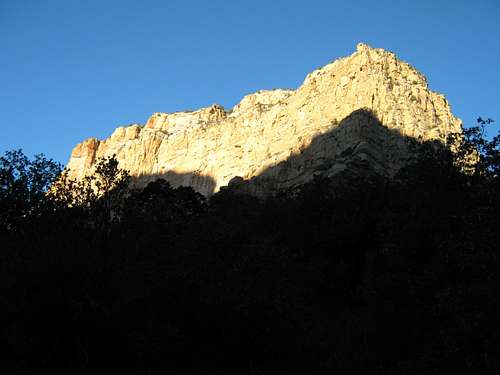
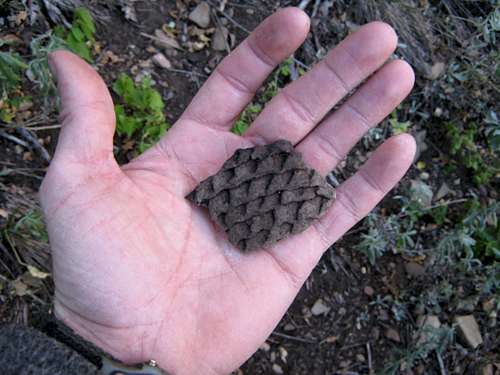
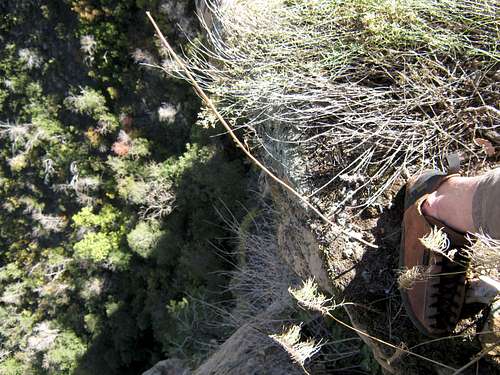
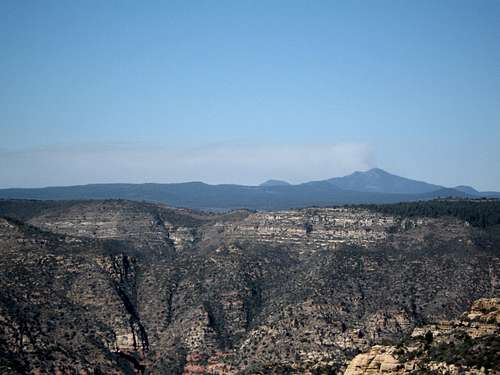
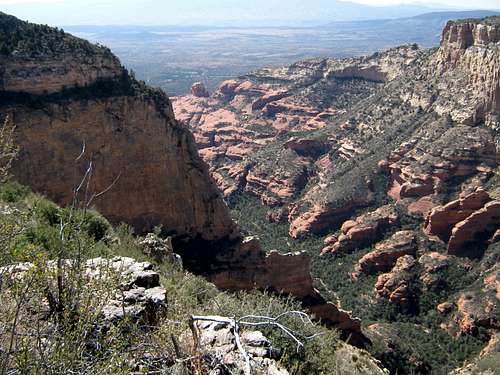
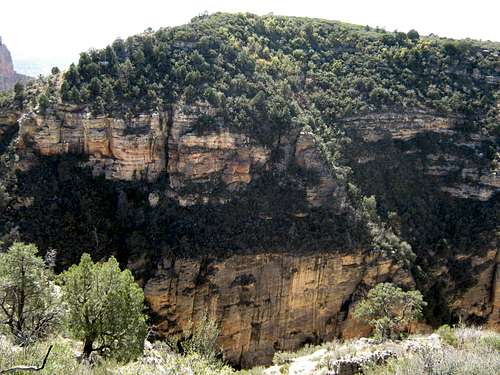
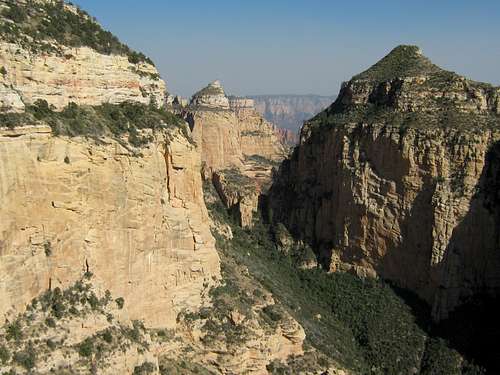
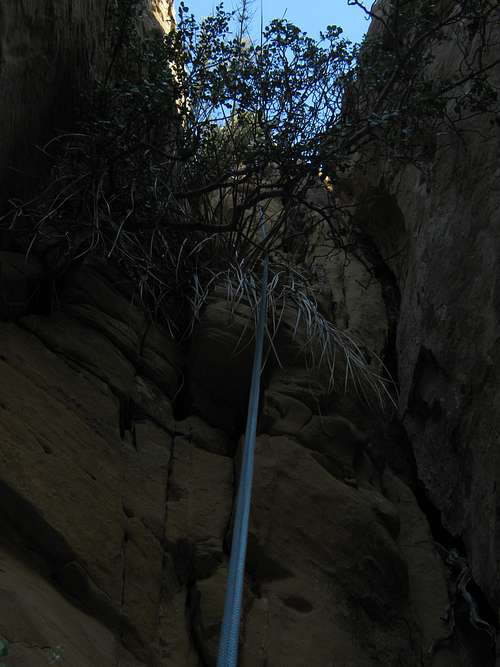



Comments
Post a Comment